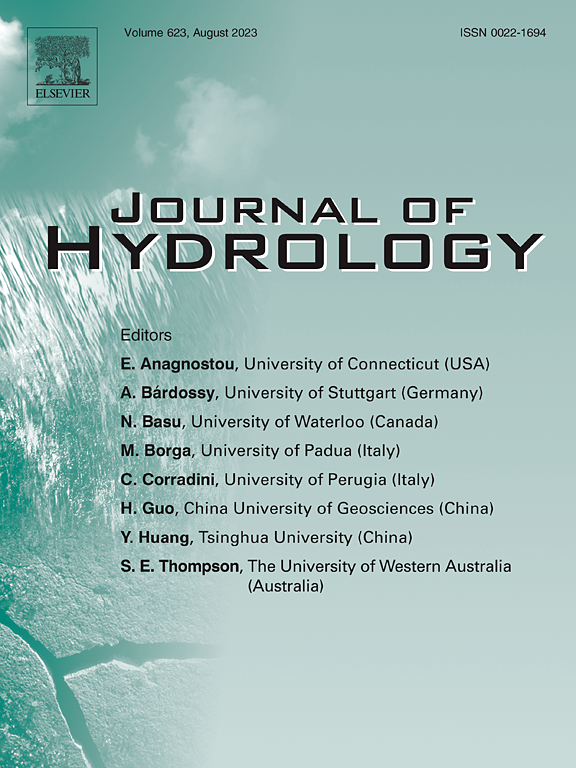2018年、2019年和2020年大洪水期间,密西西比河下游的淹没机制和河岸水质
IF 5.9
1区 地球科学
Q1 ENGINEERING, CIVIL
引用次数: 0
摘要
像密西西比河下游(LMR)那样,人为地缩小堤岸的洪泛平原在减轻洪水和最大限度地保留养分方面的能力有限。本研究通过分析连续运行传感器的水位和温度,探讨了2018-2020年三次大洪水期间的淹没机制和模式。此外,对2019年收集的原位水质测量和河岸水样进行了沉积物、吸附碳和营养物质以及溶解营养物质的分析。结果表明,早期上升翼期的地下渗流引起深漫滩水体水位上升,随后是远漫滩的回水淹没、决口激活,最后在最大阶段附近自然堤防漫过。2019年3月和6月的河岸水样显示,溶解的硝酸盐-亚硝酸盐(54% &;减少24%),磷(27% &;减少29%),悬浮沉积物浓度(70% &;比上游的LMR河道低59%,表明河滩的营养物质滞留和泥沙淤积;随着离海峡岸的距离的增加,这种下降趋势在一定程度上支持了研究结果。相反,吸附碳的质量百分比(235% &;68%)和氮(300% &;比LMR河道高125%,这是由于天然堤坝上的泥沙淤积和吸附细粒沉积物的持续悬浮造成的。随后的细颗粒沉降将碳和氮保留在洪泛区沉积物中。这些发现表明,在长时间洪水期间,泥沙沉积和营养物质滞留的模式和模式随着阶段的调整而变化,而深度淹没的河堤平原仍具有滞留能力,而细沉积物和营养物质主要绕过下游。本文章由计算机程序翻译,如有差异,请以英文原文为准。
Inundation mechanisms and overbank water quality along the lower Mississippi River during the major floods of 2018, 2019, and 2020
Artificially narrowed embanked floodplains, like those along the lower Mississippi River (LMR), are limited in their capacity to attenuate flooding and maximize nutrient retention. This study examines mechanisms and patterns of inundation during three major LMR floods (2018–2020) by analyzing water levels and temperatures from continuously operating sensors. Additionally, in-situ water quality measurements and overbank water samples collected in 2019 were analyzed for sediment, sorbed carbon and nutrients, and dissolved nutrients. Results indicate that subsurface seepage during the early rising limb initiates water-level increases in deep floodplain water bodies, followed by backwater inundation of distal floodplains, crevasse activation, and finally overtopping of natural levees near maximum stages. Overbank water samples from March and June 2019 indicate that dissolved nitrate-nitrite (54% & 24% less), phosphorus (27% & 29% less), and suspended-sediment concentrations (70% & 59% less) were lower than the LMR channel upstream, indicating nutrient retention and sediment deposition in the embanked floodplain; findings are partly supported by declining trends with distance from the channel bank. Conversely, mass percentages of sorbed carbon (235% & 68% more) and nitrogen (300% & 125% more) were higher than the LMR channel, resulting from sand deposition on natural levees and continued suspension of adsorptive fine-grained sediments. Subsequent fine-grained settling retains carbon and nitrogen in floodplain deposits. These findings establish that modes and patterns of sediment deposition and nutrient retention vary as stages adjust during long-duration floods, and while deeply inundated embanked floodplains remain capable of retention, fine sediment and nutrients primarily bypass downstream.
求助全文
通过发布文献求助,成功后即可免费获取论文全文。
去求助
来源期刊

Journal of Hydrology
地学-地球科学综合
CiteScore
11.00
自引率
12.50%
发文量
1309
审稿时长
7.5 months
期刊介绍:
The Journal of Hydrology publishes original research papers and comprehensive reviews in all the subfields of the hydrological sciences including water based management and policy issues that impact on economics and society. These comprise, but are not limited to the physical, chemical, biogeochemical, stochastic and systems aspects of surface and groundwater hydrology, hydrometeorology and hydrogeology. Relevant topics incorporating the insights and methodologies of disciplines such as climatology, water resource systems, hydraulics, agrohydrology, geomorphology, soil science, instrumentation and remote sensing, civil and environmental engineering are included. Social science perspectives on hydrological problems such as resource and ecological economics, environmental sociology, psychology and behavioural science, management and policy analysis are also invited. Multi-and interdisciplinary analyses of hydrological problems are within scope. The science published in the Journal of Hydrology is relevant to catchment scales rather than exclusively to a local scale or site.
 求助内容:
求助内容: 应助结果提醒方式:
应助结果提醒方式:


